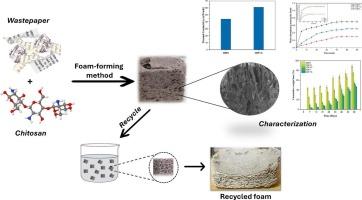Biodegradable foam from wastepaper with enhanced hydrophobicity for thermal insulation applications
IF 4.3
2区 工程技术
Q2 ENGINEERING, CHEMICAL
引用次数: 0
Abstract
This study presents the development of a novel bio-based foam utilizing wastepaper pulp as the primary raw material in response to the growing demand for sustainable and biodegradable alternatives to synthetic foams. Foams have shown great potential for multifunctional applications like packaging, insulation, and agricultural purposes. In this work, a simple oven-drying approach was developed to prepare biodegradable foams from waste newspaper (WNP), poly (vinyl alcohol) (PVA), and varying concentrations of chitosan. The resulting foam exhibited promising characteristics like high porosity (>94.71 %) and low density (0.032 g/cm3 to 0.129 g/cm3). The foam exhibited a water absorption capacity ranging from 0.2 to 0.6 g/g, with a maximum water contact angle of 114°, signifying an exceptionally hydrophobic surface and enhanced water resistance. The porous structure and interfacial contact regions contributed to the formation of a robust matrix with a smooth surface, resulting in exceptional thermal insulation (thermal conductivity of 0.04–0.06 W/(m·K)), higher biodegradability, and better mechanical properties (compressive strength in the range of 87 kPa to 154 kPa at 60 % strain). The incorporation of waste-derived cellulose not only repurposes paper waste but also contributes to a circular bioeconomy. The increase in chitosan content improved the water resistance and mechanical strength. Moreover, this biofoam has been demonstrated to be recyclable with a substantially reduced environmental impact.

从废纸中提取的可生物降解泡沫,具有增强的疏水性,用于隔热应用
本研究提出了一种新型生物基泡沫的发展,利用废纸纸浆作为主要原料,以响应对可持续和可生物降解的合成泡沫替代品日益增长的需求。泡沫在包装、绝缘和农业用途等多功能应用方面显示出巨大的潜力。在这项工作中,开发了一种简单的烤箱干燥方法,以废报纸(WNP)、聚乙烯醇(PVA)和不同浓度的壳聚糖为原料制备可生物降解的泡沫。所得泡沫具有高孔隙率(>94.71 %)和低密度(0.032 g/cm3 ~ 0.129 g/cm3)的特点。泡沫的吸水量为0.2 ~ 0.6 g/g,最大水接触角为114°,具有特殊的疏水表面和增强的耐水性。多孔结构和界面接触区域有助于形成具有光滑表面的坚固基体,从而获得出色的隔热性能(导热系数为0.04-0.06 W/(m·K)),更高的生物降解性和更好的机械性能(抗压强度范围为87 kPa至154 kPa,应变为60% %)。废物来源的纤维素的掺入不仅重新利用废纸,而且有助于循环生物经济。壳聚糖含量的增加提高了材料的耐水性和机械强度。此外,这种生物泡沫已被证明是可回收的,大大减少了对环境的影响。
本文章由计算机程序翻译,如有差异,请以英文原文为准。
求助全文
约1分钟内获得全文
求助全文
来源期刊

Chemical Engineering Science
工程技术-工程:化工
CiteScore
7.50
自引率
8.50%
发文量
1025
审稿时长
50 days
期刊介绍:
Chemical engineering enables the transformation of natural resources and energy into useful products for society. It draws on and applies natural sciences, mathematics and economics, and has developed fundamental engineering science that underpins the discipline.
Chemical Engineering Science (CES) has been publishing papers on the fundamentals of chemical engineering since 1951. CES is the platform where the most significant advances in the discipline have ever since been published. Chemical Engineering Science has accompanied and sustained chemical engineering through its development into the vibrant and broad scientific discipline it is today.
 求助内容:
求助内容: 应助结果提醒方式:
应助结果提醒方式:


